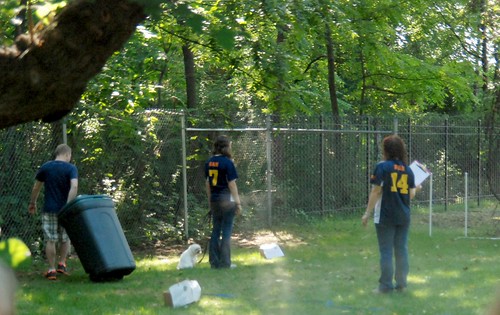CGC stands for Canine Good Citizen. It is a manners test, put on by the American Kennel Club as a way to get people started working with their dogs. As a manners test, it represents the minimum amount of training that is necessary to safely live with a dog (almost all dogs need more!). It also provides a gateway into involvement in other dog sports and dog centered activities. A well trained dog is an enjoyable one.
 Since I have been a CGC Evaluator for the past year, I have had the opportunity to see some of what works and some of what doesn't work when people take the test. While every dog is an individual, I have noticed a not-so-subtle pattern in the dogs who pass the test. The passing teams have all taught their dogs a variation of the same thing.
Since I have been a CGC Evaluator for the past year, I have had the opportunity to see some of what works and some of what doesn't work when people take the test. While every dog is an individual, I have noticed a not-so-subtle pattern in the dogs who pass the test. The passing teams have all taught their dogs a variation of the same thing.To become the proud owner of a dog that has earned his CGC certificate, teach him these things before signing up for the test.
1) To say no to distractions.
Your dog will have to say no to other dogs, people, noises, smells and sounds during the CGC test. As a carry over into real-life situations, if your dog can't say no to distractions, the dog will never be able to self regulate himself and will require close and careful management for the duration of his life. Rugby learned this lesson by doing longe line work, an exercise taught the first week of each of our programs.
2) To sit.
A reliable sit and sit/stay will get you through the accepting a friendly stranger, sitting politely for petting, part of the appearance and grooming station, part of the sit and down on command and staying in place, reaction to another dog, and reaction to distraction. That is more than half of the CGC test. Make sure your dog will sit in all environments and with lots of different distractions.
 3) To stand.
3) To stand.This is used only for the appearance and grooming test to provide the dog with a comfortable and stable position to receive grooming and for their feet to be picked up. Both dog groomers and vets require dogs be in a stand, and it is useful for wiping off muddy feet. If you haven't taught your dog a proper stand and stand/stay, you are doing him a disservice.
4) To down.
A reliable down and down/stay will be used in the sit and down on command and staying in place and can also be used for the supervised separation as an out of sight stay if you wish. Since you can use multiple signals and commands, dogs that have been introduced to, but have not mastered the down can still take and pass the CGC test (although it would be difficult to live with that dog).
5) To come when called.
Most dogs will come to you with some encouragement. Provided that you have taught the dog to say no to distractions and to hold a sit/stay, you should be OK for the test. If you have a dog that for whatever reason won't come to you, some recall work will be required. Even though you don't need extensive recall training to pass the CGC, you still need to teach it! This is crucial for all dogs to know.
Earning the Canine Good Citizen certificate is a respectable goal, and I encourage those who pass to use it as a stepping stone to other things. This training is the foundation needed to do anything and everything with your companion. Good luck!

No comments:
Post a Comment